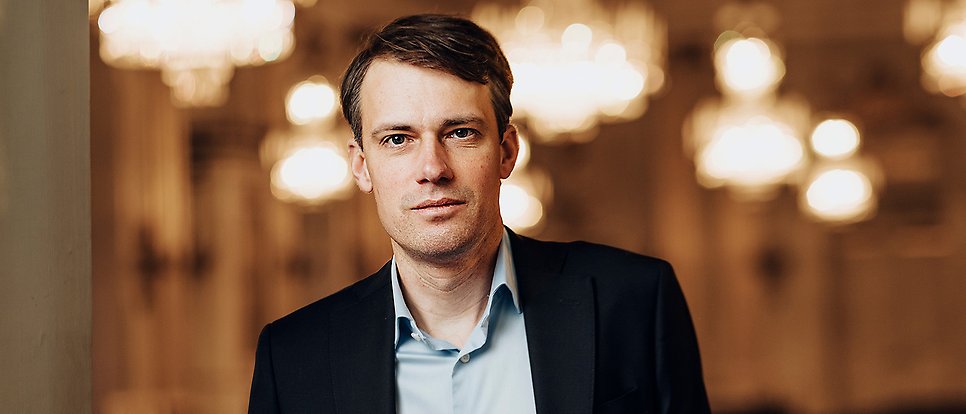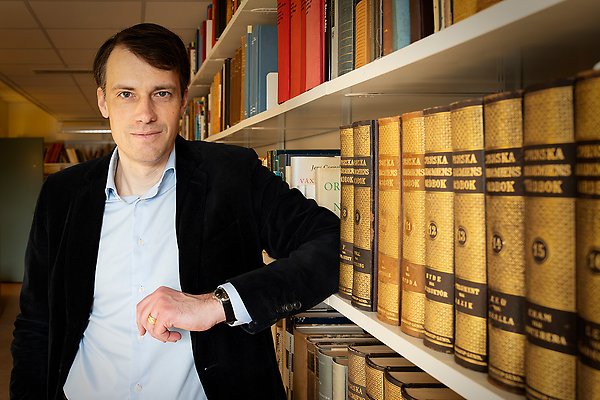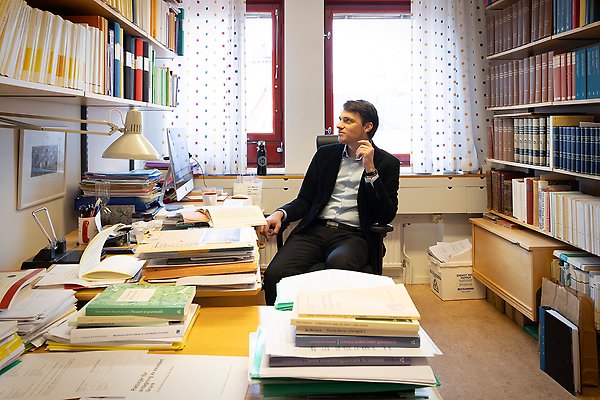David Håkansson joins Swedish Academy
Researcher profile

David Håkansson succeeds the renowned linguist Sture Allén in chair number three of the Swedish Academy. Photo: Samuel Uneus
“Swedish is a large and unusually well-described language,” notes David Håkansson, Professor of Swedish Language and Linguistics at Uppsala University. After many years of research, he has now joined the Swedish Academy and is looking forward to following the development of Swedish from a new perspective.
In December, Håkansson succeeded the renowned linguist Sture Allén in Seat 3 of the Swedish Academy. In keeping with tradition, he gave a speech on Allén, after reading up on his work and visiting his widow Solveig in Gothenburg.
“It felt great to succeed him. We don’t have quite the same interest in linguistics – he worked in lexicography and did a lot of work on dictionaries – but we share an interest in the structure of the language. That gave us a common denominator.”
Håkansson’s appointment coincided with the publication of the latest volume of the Swedish Academy’s dictionary. The dictionary is an immense project that has been maintained since the 19th century, in which all Swedish words have been thoroughly explained alongside evidence of when they were first used.
The work is now starting up once more, with several other funding bodies in addition to the Swedish Academy.
“Yes, we revisit, revise and update, because a large number of words are obviously not in the dictionaries. However, it will not be printed this time, instead becoming a purely digital product.”
Important Swedish language infrastructure
The Swedish Academy is often associated with the awarding of the Nobel Prize in Literature, formal events and celebrations. Its importance for the Swedish language is often less emphasised.
“There is a lot of work going on behind the scenes on important infrastructure for the Swedish language. For example, the dictionary is a fantastic project that we were now able to finalise. Few languages are as well described as Swedish. In addition to the dictionary, the glossary is published regularly, we have the Swedish Academy’s grammar which was published in 1999 and we are working on the website svenska.se.”

David Håkansson at the Swedish Academy´s dictionary, on the bookshelf at the Department of Nordic Languages. Photo: Mikael Wallerstedt
Håkansson will now contribute to this area of the Academy’s activities. At the same time, he will continue full-time as a researcher in Scandinavian languages and Dean of the Faculty of Languages at Uppsala University.
Changes in 19th-century Swedish
His research takes a particular interest in language changes, both in the present and in the past. He is currently completing a research project on 19th-century Swedish and how it changed both then and over the longer term.
“In particular, we are looking at how changes spread from fictional dialogue to other genres. During the 19th century, there was a perception that the gap between speech and writing had become too wide. Many linguists, not least Adolf Norén, who was a professor at the department, were committed to bringing written Swedish closer to spoken Swedish.”
This language reform used fiction writers like Selma Lagerlöf as role models.
“Authors only had this role for a fairly short period. By the time of the Second World War, journalists had already taken over as language standardisers. Since then, the language of newspapers has been the benchmark for written Swedish,” explains Håkansson.
Monitors developments in real time
In his new role, he will monitor changes in the language in real time, for example each time a new edition of the Swedish Academy’s glossary is published.
Language issues are of interest and concern to many, and it is often perceived as a deterioration when the language changes. It doesn’t have to be that way, according to Håkansson.
“Swedish has always been subject to change and it is quite natural for a language to undergo changes in vocabulary and grammar. What I find more worrying is the loss of domains that we can see today, where Swedish is not being used at all in certain areas. This has been widely recognised in higher education, for example.”
Whenever English replaces Swedish, it contributes to the dilution of the language and the loss of important words and concepts. He compares it to the transition from an agricultural to industrial society, when urbanisation dealt a heavy blow to the dialects.
“The genuine dialects cannot be brought back, and it’s the same issue here.”
Strong position globally
What is the status of Swedish among the world’s languages? A common perception is that Swedish is a small language, but this is not true, according to Håkansson.
“By European standards, we may appear to be one of the smallest languages, but in the world, Swedish is a major language. There are about 7,000 languages in the world and Swedish is one of the largest. It is by far one of the best-described languages, as well as a complete societal language that can be used in public life and administration.”

Håkansson will continue full-time as a researcher in Scandinavian languages and Dean of the Faculty of Languages at Uppsala University. Photo: Mikael Wallerstedt
As a new member of the Swedish Academy, he looks forward to many linguistic discussions in the time to come. Every week he travels to Stockholm to attend meetings.
“It’s very interesting and rewarding on many different levels, especially getting to know the people. In early April, the Academy awarded its Nordic Prize to poet Ingela Strandberg in the Stock Exchange Building, which was the first time I was involved in the outreach activities.”
An important milestone
This is of course an important milestone in a research career that began with a thesis at Lund University and continued with a move to Uppsala University in 2010, where he became a docent after two years and a professor after eight years.
How did you become interested in the Swedish language?
“I think linguistics was attractive because it was a form of structure. You could look at language from a structural point of view and combine that with an interest in how language was used,” replies Håkansson.
An interest he shares with his predecessor Sture Allén, in other words.
Annica Hulth
Facts: David Håkansson
Title: Professor of Swedish Language and Linguistics at the Department of Scandinavian Languages at Uppsala University.
Recent news: New member of the Swedish Academy
During my free time: I’m finishing a research project, and I also have a summer house in Skåne.
Latest book read: I’ll pass on that one.
Latest film seen: I like documentaries, so I’ve been watching several of Tom Alandh’s films on SVT Play.
Favourite travel destination: Apart from going to the summer house in Skåne, we like to travel to Germany.
Other languages: I used to study German back in Lund.
Driving force as a researcher: Curiosity is a major driving force. It’s also stimulating to discover patterns in large sets of material.
How I get my best ideas: In the most unexpected places, working in the garden, washing dishes or cycling between meetings in Uppsala. But maybe not always at my desk.
